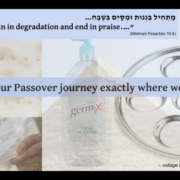Shabbat HaGadol: From Where We Are
A slide from Bayit’s Pesach offerings this year.
Many of you have heard me say that on Shabbat HaGadol, the Shabbat before Pesach, it’s customary for the rabbi to give a sermon about how to prepare for Pesach. Traditionally speaking, I’m supposed to give you instructions on how to prepare yourselves and your homes for Passover. You know — here are the five “leavenable” grains, here’s how to remove them from your homes for a week, here’s the halakha on how to properly clean to remove every last scrap of hametz.
As we approach our second pandemic Pesach, the idea of preparing for Pesach feels different than it ever has before. I mean, if you remove hametz, you can do that the same as you always have. And even if you’ve never followed that tradition, you can mark the week by making a conscious choice not to eat bread. A week of mindful eating is a valuable experience and a deep way to connect with our traditions. But that’s not the kind of preparation with which I’m grappling this year.
It’s the inner preparation that’s challenging me. Because the pandemic continues. Last year who could’ve imagined that we’d be here now: preparing for another Zoom community second night seder? Still staying apart to protect each other and ourselves. Many of us still in lockdown mode, or sheltering in place, to prevent the spread of a virus that’s still killing 1200 people each day in this country — about three times as many as last July 4; the equivalent of a 9/11 every three days.
There are three excellent vaccines out in the world now. There is reason to hope that once the population reaches a certain vaccination threshold, we will be able to be together safely again. Elementary schools are even about to re-open! But we are not “there yet.” What does it mean to prepare ourselves for liberation when many of us may still feel constrained: by pandemic, by economic challenges, by racism and all the harm it creates, by the reality of anti-maskers and anti-vaxxers?
The haggadah teaches: in every generation one must see oneself as if one had been liberated from Mitzrayim / the Narrow Place — from tzuris / suffering, from meitzarim / constrictions. How can we see ourselves as if we were going forth from those tight spaces when we are still manifestly living in them? We aren’t liberated from COVID. We aren’t liberated from racism and hatred. We will celebrate Pesach as a community again via digital means, not “in person.” What kind of liberation can this be?
Earlier this winter I worked with a group of poets, artists, rabbis, and liturgists to co-create new materials for the start of seder, recognizing the meitzarim that still bind us so that we can prepare our spirits for the liberation that is not yet quite here. (We’ll use those materials at our community seder on Zoom with Rabbi David and the TBE community — please sign up now, we need your RSVP by Wednesday!) And, there are things we can do practically to prepare our hearts to go free.
Set your seder table with a white tablecloth, if you have one. If not, use a bedsheet… or whatever festive cloth you can find. Make it feel different than on a regular night. It’s too early to have spring flowers where we live, but if you can pick up a bouquet at the grocery store, treat yourself: a symbol of spring, something beautiful and festive. Put candles on your festival table: we’ll light them to bring the light of the festival into the room and into our hearts.
Create a second seder plate memorializing this COVID year: hand sanitizer, a face mask, a vaccination card if you’re fortunate enough to have had a shot. We’ll light a memorial candle for the half a million who have died as we move through the door into this year’s community seder. And you’ll also want a “regular” seder plate symbolizing our ancestral story of freedom: an egg, a roasted shankbone or beet, a sprig of green, haroset, maror. Maybe an orange and an olive.
We’ll harness our sensory experiences to bring us into the festival of freedom. The crunch of matzah, the taste of parsley (or whatever you use for karpas, the green vegetable dipped in salt water tears), the sharpness of horseradish and sweetness of haroset… all of these will spiritually hyperlink us with seders past and seders to come. Our people have celebrated Pesach in narrow straits before. Our rituals give us strength, and they connect us with each other and with our Source.
The journey to Passover begins where we are. Not in some imagined reality where the pandemic never happened, but right here and now. And I know with all my heart that when we gather on Zoom for second night seder, the words and the tastes and the rituals will lift us out of where we are and prepare us for the unfolding of something new. The journey to Sinai. The journey to togetherness. The journey to the better world we’ll build together on the far side of the sea.
This is the d’varling that Rabbi Rachel offered at Kabbalat Shabbat services (cross-posted to Velveeteen Rabbi)






